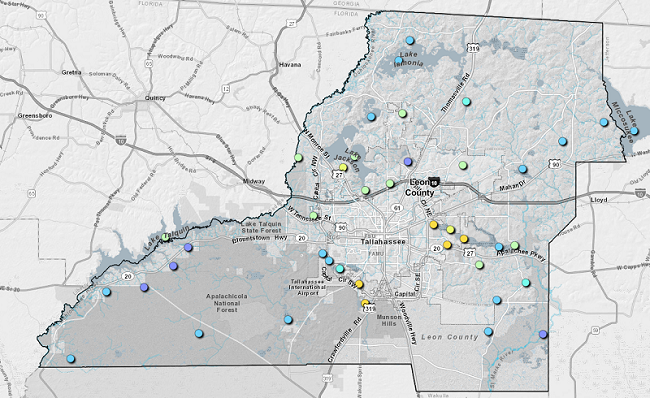Leon County staff presented the Annual Water Quality Monitoring Report during the December 13th Leon County Commission meeting. The report details the process related to collecting water samples from January through December 2021 and identified areas of concern.
Process
Throughout the year, staff collects water samples from approximately 70 locations which are then sent to a laboratory for analysis. Once the results from the samples return, the staff reviews the results for quality control.
Both of Leon County’s watersheds lead to either the Ochlockonee River or St. Marks River. Each watershed is broken down into smaller land areas or drainage basins, some of which drain into the aquifer which supplies the majority of Leon County’s water supply.
Most of Leon County’s 36 drainage basins are located in underdeveloped areas around the county. The water quality of all drainage basins exceeds the standards by the state and federal government. The report notes that expanding developments can impact the water quality of nearby lakes and streams and oftentimes mitigation efforts are required.

Data Collection
The water quality monitoring program assesses water bodies by using biological monitoring, the stream condition index, habitat assessment and lake vegetation.
The compiled data provides a more holistic approach for assessing the health of the waterbodies and collects data quarterly on around 39 water quality parameters at each of the 70 sampling stations.
Data Usage
The collected data helps assist Leon County in supervising the ecosystem health over the lakes, streams and rivers in Leon County. The information is used to document waterbody conditions, identifying operative means of stormwater management and applicable land use decisions.
The data is entered into the Florida Watershed Information Network and is used by local, state and federal agencies. Both The Florida Department of Environmental Protection and U.S Environmental Protection Agency depend on the program for evaluating waterbodies in unincorporated areas of the county that do not meet federal and state water quality standards.
The program can also be used as a tool to help measure the impact of development in unincorporated areas allowing the county to address water quality before state or federal action.
Areas with Elevated Findings
The report states that surface water health continues to be an ongoing problem in Florida. Some of the issues with poor water health can range from, toxic blue-green algal blooms, excessive invasive exotic aquatic vegetation and red tide.
Nutrient pollution of surface waters is often caused by agriculture runoff, onsite sewage treatment and disposal systems, runoff and sanitary sewer system discharges.
Intermittent algal blooms continue to be an issue for Leon County. Several lakes were observed in 2021 including Lake Munson, which has been a remaining problem. During a commission meeting on October 11th, the board approved an Action Plan for Lake Munson, including an immediate and temporary drawdown for the water level to coincide with enhanced water quality monitoring and an aerial topographic survey of the lake bottom.
In addition, the report noted that Leon County staff continue to monitor high E. coli levels in several creeks throughout the County. The elevated bacteria levels have been discussed with the appropriate utility providers and FDEP. Leon County continues to work with FDEP to further investigate for potential sources. Leon County added additional sampling stations in 2021 at both Polk and Harvey Creeks to bracket potential sources of pollution.
The full water quality report can be accessed here.


Our water in Bull Run area is hard as hell and ruins everything. Yeah, expensive water softeners help. Blah.